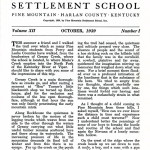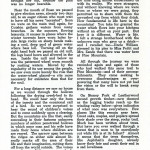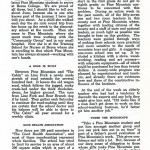Pine Mountain Settlement School
Series 17: PMSS Publications (Published by the School)
NOTES – 1939
“Notes from the Pine Mountain Settlement School”
October
GALLERY: NOTES – 1939 October
- NOTES – 1939 October, page 1. [PMSS_notes_1939_oct_001.jpg]
- NOTES – 1939 October, page 2. [PMSS_notes_1939_oct_002.jpg]
- NOTES – 1939 October, page 3. [PMSS_notes_1939_oct_003.jpg]
- NOTES – 1939 October, page 4. [PMSS_notes_1939_oct_004.jpg]
CONTENTS
NOTES – 1939 OCTOBER: Greasy Creek ; Macie’s [Mason’s] Creek ; Perry County ; Viper ; “Hen” Turner ; Rockhouse ; Leslie County ; Stoney Fork ; Line Fork ; Berea College ; road-building ; Good Health Association ; Pine Mountain Institute ; Uncle William ; Ethel de Long Zande ; Miss Pettit ; Cooperative Study of Secondary School Standards ;
…[H]ave you ever walked through a forest that is soon to be mercilessly cut while life is at it fullest? Almost it seems that the trees themselves…already know their fate and await their end in a sad loneliness.





